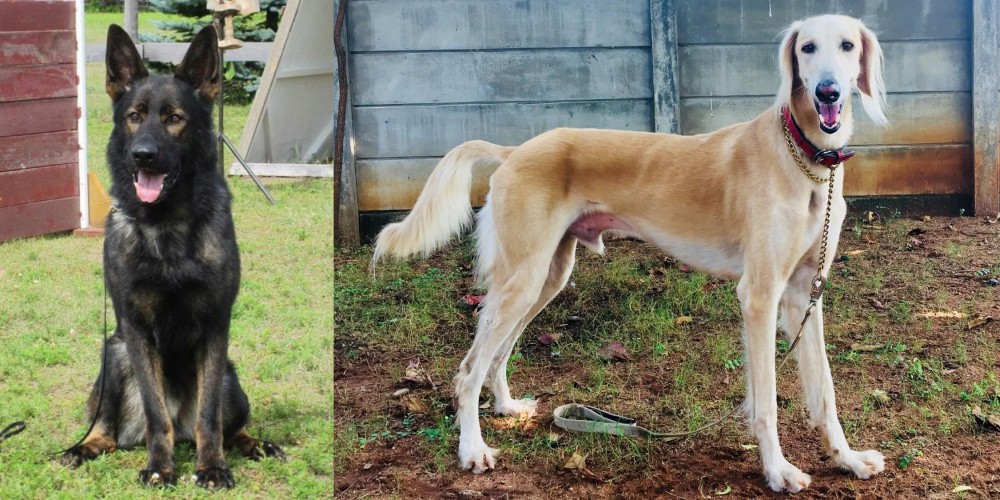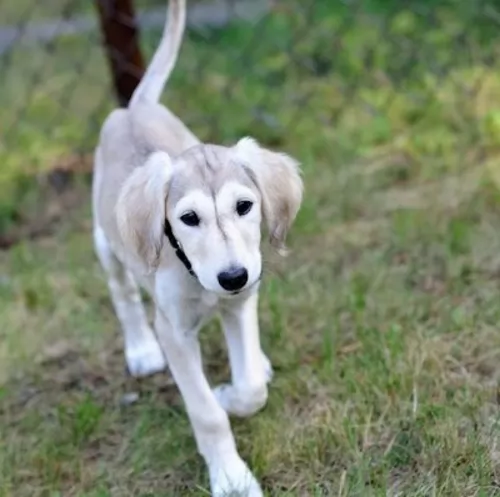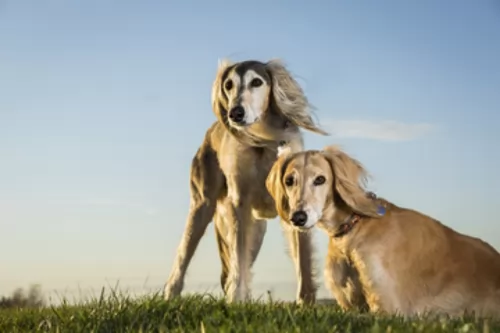 Petzlover
Petzlover East German Shepherd is originated from Germany but Saluki is originated from Iraq. East German Shepherd may grow 6 cm / 2 inches shorter than Saluki. East German Shepherd may weigh 10 kg / 23 pounds more than Saluki. Both East German Shepherd and Saluki has almost same life span. Both East German Shepherd and Saluki has almost same litter size. East German Shepherd requires High Maintenance. But Saluki requires Moderate Maintenance
East German Shepherd is originated from Germany but Saluki is originated from Iraq. East German Shepherd may grow 6 cm / 2 inches shorter than Saluki. East German Shepherd may weigh 10 kg / 23 pounds more than Saluki. Both East German Shepherd and Saluki has almost same life span. Both East German Shepherd and Saluki has almost same litter size. East German Shepherd requires High Maintenance. But Saluki requires Moderate Maintenance
 The East German Shepherd is a line of the German Shepherd Dog breed. The German Shepherd Dog came about when the three types of “continental shepherd dogs” separated into the Dutch Shephers, German Shepherd and Belgian Shepherd. In the 1800’s it was local shepherds who bred their dogs and selected the traits they needed in their geography. The result was dogs in various local areas who all could herd and guard flocks; who were intelligent, strong, fast and had a good sense of smell, but their appearance and skills varied from town to town.
The changes in Germany from agriculture and sheep to industrial cities rendered the German Sheep Dog obsolete. But was it really? Many felt the dog could be a good working dog in the cities as well but needed some refinement in the breed according to Max von Stephanite. At a dog show in 1899, he found what he wanted – the perfect working dog.Stephanitz bought the dog and founded the Society for the German Shepherd. (Verein fur Deutsch Schaferhunde) Stephanitz is considered the developer of the German Shepherd Dog.
The East German Shepherd is a line of the German Shepherd Dog breed. The German Shepherd Dog came about when the three types of “continental shepherd dogs” separated into the Dutch Shephers, German Shepherd and Belgian Shepherd. In the 1800’s it was local shepherds who bred their dogs and selected the traits they needed in their geography. The result was dogs in various local areas who all could herd and guard flocks; who were intelligent, strong, fast and had a good sense of smell, but their appearance and skills varied from town to town.
The changes in Germany from agriculture and sheep to industrial cities rendered the German Sheep Dog obsolete. But was it really? Many felt the dog could be a good working dog in the cities as well but needed some refinement in the breed according to Max von Stephanite. At a dog show in 1899, he found what he wanted – the perfect working dog.Stephanitz bought the dog and founded the Society for the German Shepherd. (Verein fur Deutsch Schaferhunde) Stephanitz is considered the developer of the German Shepherd Dog.
The East German Shepherd is a line of the same breed. There are several different lines of the German Shepherd Dog, with slight difference for the reason they were bred. For instance, the German Shepherd Dog is bred for looks while the East German Shepherd is bred to be a working dog. Often called a DDR German Shepherd, they came about from the Deutsche Democratic Republic or the Republic of East Germany. For about 40 years in East Germany these dogs were bred only within the DDR bloodline.
The East German Shepherd is stronger, heavier boned, leaner, more muscular and solid. During the time of the Berlin Wall, from 1961-1989, there were few German Shepherds for breeding stock on either side of the wall, but especially in the East. There the government controlled the development of the breed. They developed a separate registry for the DDR – East German Shepherd. With such strict standards for a perfect working dog and such little breeding stock, the only dogs allowed to reproduce were the ones that passed a rigorous test and were deemed perfect working dogs.
In West Germany they continued to breed for appearance. The West German Shepherd are the most popular ones and are usually simply called German Shepherds. The show dogs of today and the American line came from the West.
Preserving the East German Shepherd today is important and difficult. It means preserving not improving. The Strength of the East German Shepherd is their body line and style, Today’s breeder must maintain this while making sure there is enough diversity in the gene pool to keep the line healthy without losing its body style and working temperament. It is important that the East German Shepherd have a straight back rather than the sloping one of the German Shepherd Dog or the American lines of the GSD. The working dog is also more aggressive and has a much higher work drive than any of the other German Shepherd Dogs lines.
 It seems as though the Saluki's origins go far back to ancient Egypt times. The dog is known for its superb hunting abilities.
It seems as though the Saluki's origins go far back to ancient Egypt times. The dog is known for its superb hunting abilities.
These dogs have been known in the Middle East and could be found in Iran and Egypt too. Breeding with other dogs was forbidden so the Saluki has remained unchanged for thousands of years.
It has always been known over the centuries for its superb grace and speed as well as endurance. He is capable of that because of the tall, sleek, muscular body and long, narrow head.
The Saluki came to England in the 1900s, and today the dog comes in quite a few variations.
 What are the differences between the German Shepherd Dog (GSD) and the East German Shepherd? The East German Shepherd has a straight back and a larger bone structure. He has a very large and block shaped head with a lean, athletic build. His lips are taunt and dark, and his nose must be black. He has a scissor bite and strong teeth. His eyes are medium sized almonds that are slanted slightly. The eyes are also very dark. His ears are erect and not too big. His legs, haunches and feet must all be coordinated so that he trots rather than runs.
What are the differences between the German Shepherd Dog (GSD) and the East German Shepherd? The East German Shepherd has a straight back and a larger bone structure. He has a very large and block shaped head with a lean, athletic build. His lips are taunt and dark, and his nose must be black. He has a scissor bite and strong teeth. His eyes are medium sized almonds that are slanted slightly. The eyes are also very dark. His ears are erect and not too big. His legs, haunches and feet must all be coordinated so that he trots rather than runs.
 The Saluki is a graceful, elegant looking dog, deep chested and long legged, much like the Greyhound and fairly closely related to the Afghan Hound.
The Saluki is a graceful, elegant looking dog, deep chested and long legged, much like the Greyhound and fairly closely related to the Afghan Hound.
They stand at between 58 and 71cm and weigh between 16 to 29kg. The head is long and narrow, the eyes large and the dog has floppy ears. The tail is long and curved. The coat of the Saluki comes in a number of different colours and these can be fawn, cream, white, tan, some black or it can have a blend of all these colours. The coat of this dog comes in two types - smooth and the feathered type. The fur is always beautifully silky and is considered to be low-shedding.
These dogs are also very fast runners, and if you check the Guinness Book of Records, you’ll see that the Saluki is listed there as being one of the fastest dogs with tremendous stamina.
Th Saluki is a beautiful, quiet, dignified, reserved, loyal dog. You can just see that he is intelligent. He is certainly affectionate with his human family but you wouldn’t call him demonstrative. He isn’t the kind of dog to be wildly prancing around wagging his tail furiously.
He’s the kind of dog that likes to give chase so you’ll need a large garden for him. It’s why he isn’t suited for city life on a small property. The countryside is a far better option for this tall dog.
When he’s not outdoors, he can easily curl up on your sofa for a few hours of utter relaxation. Training and socialization will be necessary for this shy dog as it not only makes him obedient, but it gives him some confidence with knowing how to behave in different circumstances. He’ll get on well with older children, but is fairly indifferent and intolerant to small kids, especially those that are undisciplined and left to climb over him.
 The East German Shepherd is a well- balanced dog. He is sure of himself, friendly, loyal and wants to please his owner. He is intelligent, resilient and attentive. He will make a great family pet. He is aggressive with a high prey drive but that can be tempered with good socialization and training. He is easy to train.
The East German Shepherd is a well- balanced dog. He is sure of himself, friendly, loyal and wants to please his owner. He is intelligent, resilient and attentive. He will make a great family pet. He is aggressive with a high prey drive but that can be tempered with good socialization and training. He is easy to train.
 The Saluki loves his human family, and he’s the kind of dog that wouldn’t like to be owned by one family ad then given away to another later on. That's why make sure when you get your Saluki your intentions are to keep him.
The Saluki loves his human family, and he’s the kind of dog that wouldn’t like to be owned by one family ad then given away to another later on. That's why make sure when you get your Saluki your intentions are to keep him.
He likes to be comfortable too when they’re not running outside, and a good bed is important to him. Salukis are naturally thin, so make sure not to overfeed him. These are quiet, calm dogs, but over the centuries they've been making reliable, steadfast pets and companions.
 Because the East German Shepherd line has been isolated behind the Berlin Wall, there are not many genetic health issues in the line. Most importantly the East German Shepherd shows no hip dysplasia which plagues most GSD. There are a couple of situations to look out for. They are:
Because the East German Shepherd line has been isolated behind the Berlin Wall, there are not many genetic health issues in the line. Most importantly the East German Shepherd shows no hip dysplasia which plagues most GSD. There are a couple of situations to look out for. They are:
A life threatening issue that must be addressed immediately for fear of death. Bloat is caused when a larger dog with a deep chest eats too large a meal before or after strenuous exercise, eats too fast, or drinks too much water. The stomach distends with air or gas and twists. Sometimes it is completely inverted. Get help fast or your dog will die.
 We always mention hip dysplasia as a common dog ailment as so many dog breeds can succumb to this ailment. With the Saluki, hip dysplasia is uncommon. Cancer and cardiac issues are more prevalent with these dogs.
We always mention hip dysplasia as a common dog ailment as so many dog breeds can succumb to this ailment. With the Saluki, hip dysplasia is uncommon. Cancer and cardiac issues are more prevalent with these dogs.
It is sad to realize that dogs are susceptible to the same types of cancer as people are. If the uncontrolled growth of cells in the body isn’t discovered in time, cancer can reach the circulatory or lymph systems and other parts of the body. In fact, cancer is the leading cause of death with dogs. The good news is that it is treatable if you catch it in the early stages.
One of the more common types of cancer in dogs is Lymphoma. This can affect any dog, and at any age too. There are swollen lymph nodes under the neck and the dog can have trouble with breathing and digestion. You’ll notice lumps underneath the dog's skin, abnormal discharges from the eyes, ears or rectum, non-healing wounds, coughing and pain.
 Because these dogs were bred to work you need to feed them a high quality dry food, made for working dogs. It needs to have a good amount of calcium and glucosamine. Feed about 3-4 cups per day divided into 2 feeding times.
Because these dogs were bred to work you need to feed them a high quality dry food, made for working dogs. It needs to have a good amount of calcium and glucosamine. Feed about 3-4 cups per day divided into 2 feeding times.
In addition to bloat as mentioned above, the East German Shepherd can also have both air born, and food born allergies. These are easily treated by your veterinarian.
The East German Shepherd is a high energy, high activity dog so you have some for him. He is agile and athletic. He needs serious exercise and a job is essential. If you can’t give an East German Shepherd a job, then don’t get this dog. He loves tracking and has a high prey drive. Keep him trained, challenged and working. Try tracking and herding trials, obedience, agility, fly ball and bar hunt.
 These tall, slender dogs love to run free and it's the kind of dog that will need regular and different forms of exercise.
These tall, slender dogs love to run free and it's the kind of dog that will need regular and different forms of exercise.
Provide your Saluki with a comfortable, warm, dry bed with lots of padding.
The Saluki has smooth, silky hair so brush it twice a week to keep it gleaming.
To help your Saluki have a strong immune system, he needs the best food there is. Good food packed with vitamins and minerals instead of preservative and colorants will help him fight diseases like cancer.
Commercially manufactured dog foods can be wonderfully convenient and nutritious if you get the better quality ones. Give him some home-made food too and add it twice a week to the dry kibble. This will provide variety and a tasty treat. Boiled chicken, brown rice, sweet potatoes, carrots and spinach are simple foods – just like dogs want.
Try and include some raw meat occasionally. Fresh, cool water should always be available around the clock.